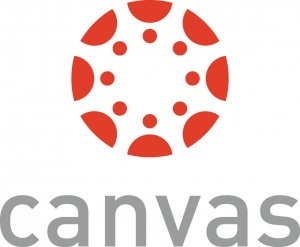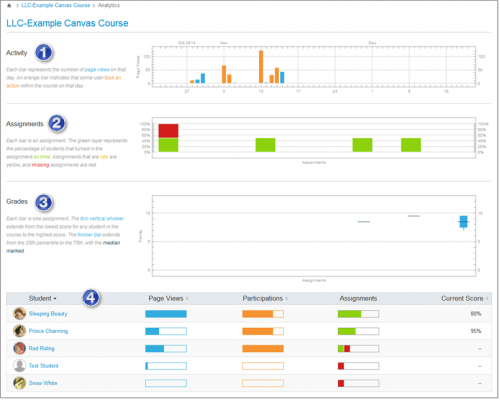Canvas
Canvas LMS, by Instructure Inc., is a web-based learning management system, marketed for use in K-12 schools, higher education and large businesses, to provide an interface for educators and students to interact, complete coursework, and receive feedback on submissions[1].
Contents
Overview

Canvas is defined as “an open and reliable web-based software that allows institutions to manage digital learning, educators to create and present online learning materials and assess student learning, and students to engage in courses and receive feedback about skill development and learning achievement”[3]. Canvas provides an array of features for both students and instructors. Some of these features are as follows: Files, Calendar, Syllabus, Assignments, Grades, Discussion boards, Zoom links, People, etc. Per teachers' preferences, everything a student may need for a course is conveniently stored in one organized interface location. In addition, Canvas has three iOS apps: Canvas Student, Canvas Teacher, and Canvas Parent[4]. These allow for each type of user to stay aware of course content when they may not have access to a computer. Likewise, it allows users to get notifications from the app to stay up-to-date on announcements and submissions. While Canvas competes with other learning management systems such as Blackboard and Google Classroom, the demand for these systems is expected to increase[5]. In August of 2020, thirteen states adopted Canvas to utilize as their statewide educational system[6], making it the number one Learning Management System in North America[1].
History of Canvas

LMS (Learning Management System) is an infrastructure that was developed in the 1990s to handle all aspects of the learning process (grading, different types of analytics, discussions, etc.)[8]. Learning Management Systems initially allowed for teachers to disseminate course content to their students remotely[9], increasing efficiency in streamlined education. As the use of technology became more widespread and the market turned toward easy to use interfaces that connected users quickly, Canvas was created. In 2008, computer scientists Devlin Daley and Brian Whitmer created Canvas with the goal of creating an intuitive Learning Management System[9].
Course Analytics

When an instructor first logs into Canvas, they can click on Course Analytics to view a graph or table representation of each students' data[11]. These analytics are divided into four categories: activity, submissions, grades, and student analytics. Activity measures a student's participation and engagement, highlighting the number of page views and levels of interactions with course content. The submissions tab refers to the quizzes and assignments that are distributed. This category measures the timeliness as far as when a student submits their assignments compared to the due date. In addition, the grades section offers a box and whisker plot of the class grade distribution. This plot describes the median, lowest, and highest scores produced by the class, allowing the teacher to retrieve a comprehensive glimpse of a student’s success relative to their peers[12]. The final measurement, student analytics, gives a breakdown of these groups categorized by student, providing an overall view of this students’ progress, or lack thereof, in a course[11].
Educator Insights
The Canvas platform provides educators with a great deal of classroom insight through the LMS method of instruction. Before the COVID-19 pandemic, in-person instruction was much more common than virtual instruction. With in-person instruction, instructors can grasp a sense of how students are interacting with the class and course material. Conversely, with virtual instruction and the use of Canvas Analytics, teachers are able to enhance their assessment of the class at large by monitoring student activity directly on the individual and group level via the course page. Using Canvas Analytics to Ensure Student Engagement. Retrieved March 12, 2021, from https://otl.du.edu/using-canvas-analytics-to-ensure-student-engagement/</ref>. With this unprecedented amount of data, teachers may infer potential causation for why one student is falling behind compared to another, by assessing their time spent engaging with the course material and utilizing certain resources provided by the instructor.
Ethical Ramifications
Data Collection
The primary purpose of teachers' access to an enormous amount of data is to better understand the level of commitment and overall engagement presented by each student in a course, however, there is no reassurance by Instructure that analytical information is not being used for any other purpose [13]. A substantial amount of potentially valuable, identifying information can be drawn from Canvas, including messages on forums along with questionnaires that have been created by students [14]. This data is a prime candidate for use with predictive analytics systems in an effort to improve the software or build profiles from users without their knowledge or consent[15]. While an increasing number of universities and other school systems have adopted Canvas, these institutions are ill prepared to handle the privacy concerns that come with mandating faculty and student use of the platform [15].
Additionally, Canvas does not give users a choice to opt-out of this data collection[16]. Especially for students, as many institutions require students to utilize Canvas for submitting assignments and receiving grades without even realizing what data of theirs is being gathered. Unizin, an organization of higher-level learning institutions, developed contracts that allow the sharing of all data between other institutions[17]. They stress the ways in which lack of transparency regarding data gathering and use by Canvas through an institution creates risks of privacy breaches, poorly representative data models, and/or legal action taken against that institution[13]. Despite these repercussions, the majority of educators utilizing the Canvas platform do not present any sort of mission statement regarding the protection of user data being passed through the LMS[13].
Educator Transparency
Due to a global pandemic, universities have been forced to implement a virtual learning system to maintain a substantive academic experience, however, this transition has exacerbated already prominent concerns about surveillance and privacy[18]. Although students are familiar with the structure of Canvas, the significance of this platform as an asset to the universities it serves, has increased due to the vast array of functions and features available [18]. In addition, due to the pandemic the way in which students learning changed so rapidly, which provided little time for instructors to look into learning systems prior to implementation.
After a year of online courses due to COVID-19, it is clear that the level of transparency and communication between students and teachers is minimized due to the nature of not only completing coursework online but never attending a class in-person[19]. For example, when students come to professors seeking advice or counsel on how to improve their grade, the professor can refer to the data provided by Canvas to convey to the student, how and why their level of interaction with the course, correlates with their grade[19].
Disabilities
Educational institutions must ensure the equal opportunity for persons with disabilities to succeed in their academic goals [20]. Pendergast states, "University courses and the policies created to support students with disabilities are subject to a multitude of laws"[20]. While there are many rules and guidelines in place for students with disabilities, these need to be modified for online learning. Many situations that seem easy to accommodate during in-person schooling are not yet available in an online setting. Due to how quickly life converted from in-person to remote schooling, it has posed issues for educators. For example, a deaf student is usually provided an interpreter for in-person schooling, whereas online, Canvas provides a dictation software. However, it has been shown to have, on average, one error per sentence which in turn puts students with disabilities at a disadvantage[20]. Furthermore, lack of attendance cannot be penalized for a student with disabilities. When the journal was published in 2015, Canvas had no such function for tracking attendance, so there was no way to see what a student missed[20].
Grading
The plausibility for error in student assessment is significant because, on a personal level, each student is entitled to their preferred learning strategy[21]. This level of oversight by the teachers has raised concern for students because of the lack of privacy as well as how objective the assessment is[21]. More often than not, each student will engage with a certain amount of course material that they see fit. Some require more effort than others to achieve success and the uncertainty in whether a teacher will only use these analytics as a direct correlation to their success or not may be a concern for students[22]. It suggests that regardless of the overall outcome, a teacher could primarily assess a student’s work due to the data presented by Course Analytics, increasing their risk of having an incomplete understanding of the student’s overall achievement[22].
Change in Educator's Plans
With Canvas, instructors can choose how they would like their course to appear. Many instructors plan on their students accessing Canvas through a laptop or desktop, however some students may be accessing Canvas through a smartphone or tablet[23]. So, instructors may plan for their students to have a certain experience using Canvas on their laptops and instead students may be experiencing something else on their phone or tablet. This could lead to differences in what and how students are acquiring information which could lead to inequities in the classroom.
Hesitancy in Use
Even though Canvas is becoming increasingly popular, especially with the rise of the pandemic, there are still some people who are hesitant to use it. It has been found more likely that instructors from business and economics backgrounds tend to utilize Canvas more than instructors from fine arts and life science backgrounds [24]. Because of this gap in usage, students might be getting different and unequal remote learning experiences. And, in order to better close this gap, instructors are calling upon educational institutions to offer proper, subject-specific training[24].
Notes
- ↑ 1.0 1.1 Canvas Overview. (n.d.). Retrieved March 12, 2021, from https://www.instructure.com/canvas
- ↑ Empson, R. (2012, November 01). With 4.5M Users, Instructure Takes On The Courseras & Udacities Of The World With Its Own Open Course Network. Retrieved March 12, 2021, from https://techcrunch.com/2012/10/31/instructure-canvas-network/
- ↑ What is Canvas? (2021, March 05). Retrieved March 12, 2021, from https://community.canvaslms.com/t5/Canvas-Basics-Guide/What-is-Canvas/ta-p/45
- ↑ Canvas Apps. (n.d.). Retrieved March 26, 2021, from https://canvas.instructure.com/courses/1045977/pages/canvas-apps
- ↑ LMS Market. (n.d.). Retrieved March 12, 2021, from https://www.marketsandmarkets.com/Market-Reports/learning-management-systems-market-1266.html
- ↑ Instructure, C. (2020, August 20). 13 States partner with Canvas LMS to Support educators, students, and parents. Retrieved March 12, 2021, from https://www.prnewswire.com/news-releases/13-states-partner-with-canvas-lms-to-support-educators-students-and-parents-301115753.html
- ↑ Israelsen-Hartley, Sara. "BYU Grads Introduce Education-savvy Software." Deseret News. Deseret News, 20 June 2010. Web. 01 Apr. 2021.
- ↑ Watson, William R., and Sunnie Lee Watson. "An Argument for Clarity: What Are Learning Management Systems, What Are They Not, and What Should They Become?" TechTrends 51.2 (2007): 28-34. Print.
- ↑ 9.0 9.1 John, Ryan. Canvas LMS Course Design. 2014. Print.
- ↑ Viewing Course Data. (n.d.). Retrieved March 12, 2021, from https://lakeland.instructure.com/courses/740304/pages/viewing-course-data
- ↑ 11.0 11.1 What do Instructors see for Analytics or Statistics in Canvas? (2016, September). Retrieved March 12, 2021, from https://canvas.colostate.edu/wp-content/uploads/sites/41/2018/05/CanvasAnalyticsIntro_WebVersion.pdf
- ↑ Analytics in Canvas. (n.d.). Retrieved March 26, 2021, from https://bostoncollege.instructure.com/courses/1292000/pages/analytics-in-canvas
- ↑ 13.0 13.1 13.2 Ann Hill Duin, Jason Tham, The Current State of Analytics: Implications for Learning Management System (LMS) Use in Writing Pedagogy, Computers and Composition, Volume 55, 2020, 102544, ISSN 8755-4615, https://doi.org/10.1016/j.compcom.2020.102544.
- ↑ Rubio Fernandez, A., Santamaria Gonzalez, F., Munoz Merino, P. J., & Delgado Kloos, C. (2017). A Data Collection Experience with Canvas LMS as a Learning Platform. CEUR Workshop Proceedings, 1925(1613-0073). Retrieved from http://ceur-ws.org/Vol-1925/paper11.pdf
- ↑ 15.0 15.1 Roxana Marachi & Lawrence Quill (2020) The case of Canvas: Longitudinal datafication through learning management systems, Teaching in Higher Education, 25:4, 418-434, DOI: 10.1080/13562517.2020.1739641
- ↑ Young, J. R. (2020, January 17). As Instructure Changes Ownership, Academics Worry Whether Student Data Will Be Protected. Retrieved March 26, 2021, from https://www.edsurge.com/news/2020-01-17-as-instructure-changes-ownership-academics-worry-whether-student-data-will-be-protected
- ↑ Unizin. (n.d.). Retrieved March 26, 2021, from https://unizin.org/about/
- ↑ 18.0 18.1 Strauss, V. (2020, March 23). As schooling rapidly moves online across the country, concerns rise about student data privacy. Retrieved March 12, 2021, from https://www.washingtonpost.com/education/2020/03/20/schooling-rapidly-moves-online-across-country-concerns-rise-about-student-data-privacy/
- ↑ 19.0 19.1 Lederman, D. (2019, October 30). Professors' slow, steady acceptance of online learning: A Survey. Retrieved March 12, 2021, from https://www.insidehighered.com/news/survey/professors-slow-steady-acceptance-online-learning-survey
- ↑ 20.0 20.1 20.2 20.3 Pendergast, Mark, "Leveraging Learning Management System to Accommodate Students with Disabilities: Issues and Experiences with the Canvas LMS" (2015). SAIS 2015 Proceedings. 36. https://aisel.aisnet.org/sais2015/36
- ↑ 21.0 21.1 Biederman, A. (2017, October 10). Professors can monitor student activity through Canvas. Retrieved March 12, 2021, from https://temple-news.com/professors-can-monitor-student-activity-canvas/
- ↑ 22.0 22.1 Martin, Florence and Ndoye, Abdou, Using Learning Analytics to Assess Student Learning in Online Courses, Journal of University Teaching & Learning Practice, 13(3), 2016. Available at:http://ro.uow.edu.au/jutlp/vol13/iss3/7
- ↑ Wilcox, D., Thall, J. & Griffin, O. (2016). One Canvas, Two Audiences: How Faculty and Students use a Newly Adopted Learning Management System. In G. Chamblee & L. Langub (Eds.), Proceedings of Society for Information Technology & Teacher Education International Conference (pp. 1163-1168). Savannah, GA, United States: Association for the Advancement of Computing in Education (AACE). Retrieved April 1, 2021 from https://www.learntechlib.org/primary/p/171838/.
- ↑ 24.0 24.1 Fathema, Nafsaniath, and Mohammad H. Akanda. "Effects of Instructors’ Academic Disciplines and Prior Experience with Learning Management Systems: A Study about the Use of Canvas." Australasian Journal of Educational Technology (2020): 113-25. Print.